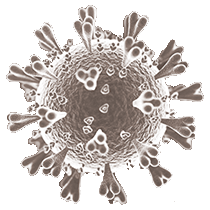Experiencia en el manejo de pacientes graves con COVID-19 en una unidad de terapia intensiva
J Ojino Sosa-García, Alan O Gutiérrez-Villaseñor, Alondra García-Briones, Juan P Romero-González, Eva Juárez-Hernández, Octavio González-Chon
Cirugía y Cirujanos, doi:10.24875/ciru.20000675
Objetivo: Describir las características clínicas y el manejo de pacientes graves con COVID-19. Método: Estudio observacional, descriptivo, longitudinal y restrospectivo. Resultados: Ingresaron 56 pacientes, el 80.3% (n = 45) de sexo masculino, con un promedio de edad de 58 [46-67] años. Las principales condiciones de comorbilidad fueron obesidad, hipertensión y diabetes. El tiempo de inicio de los síntomas al ingreso fue de 9 [7-14] días, siendo los más frecuentes disnea, fiebre y tos seca. Los datos de laboratorio fueron linfopenia y elevación de deshidrogenasa láctica, fibrinógeno, dímero D, ferritina y proteína C reactiva. El 100% de los pacientes requirieron ventilación mecánica, con una mediana de tiempo de ventilación de 12 [6-17] días, y el 66% (n = 37) requirieron posición en prono. El tratamiento farmacólogico fue a base de azitromicina, hidroxicloroquina, tocilizumab y esteroides, principalmente. Las complicaciones más frecuentes fueron lesión renal aguda, enfermedad tromboembólica venosa e infarto agudo al miocardio. La tasa de mortalidad fue del 17.8% (n = 10). Conclusión: Los pacientes graves en nuestro hospital fueron en su mayoría personas de la tercera edad y con obesidad, siendo las variables de mayor puntaje SOFA y lesión renal aguda las asociadas con mayor mortalidad.
References
Arentz, Yim, Klaff, Lokhandwala, Riedo et al., Characteristics and outcomes of 21 critically ill patients with COVID-19 in Washington State, JAMA
Bhatraju, Ghassemieh, Nichols, Kim, Jerome et al., Covid-19 in critically ill patients in the Seattle Region -case series, N Engl J Med
Cao, Wang, Wen, Liu, Wang et al., A trial of lopinavir-ritonavir in adults hospitalized with severe Covid-19, N Engl J Med
Dong, Du, Gardner, An interactive web-based dashboard to track COVID-19 in real time, Lancet Infect Dis
Gautret, Lagier, Parola, Hoang, Meddeb et al., Hydroxychloroquine and azithromycin as a treatment of COVID-19: results of an open-label non-randomized clinical trial, Int J Antimicrob Agents,
doi:10.1016/j.ijantimicag.2020.105949Grasselli, Zangrillo, Zanella, Antonelli, Cabrini et al., Baseline characteristics and outcomes of 1591 patients infected with SARS-CoV-2 admitted to ICUs of the Lombardy Region, Italy, JAMA
Grein, Ohmagari, Shin, Diaz, Asperges et al., Compassionate use of remdesivir for patients with severe COVID-19, N Engl J Med
Guan, Ni, Hu, Liang, Ou et al., Clinical characteristics of coronavirus disease 2019 in China, N Engl J Med
Huang, Wang, Li, Ren, Zhao et al., Clinical features of patients infected with 2019 novel coronavirus in Wuhan, China, Lancet
Reding-Bernal, Sánchez-Pedraza, Moreno-Macías, Sobrino-Cossio, Barrera et al., Heritability and genetic correlation between GERD symptoms severity, metabolic syndrome, and inflammation markers in families living in Mexico City, PLoS One
Richardson, Hirsch, Narasimhan, Crawford, Mcginn et al., Presenting characteristics, comorbidities, and outcomes among 5700 patients hospitalized with COVID-19 in the New York City area, JAMA
Wang, Hu, Hu, Zhu, Liu et al., Clinical characteristics of 138 hospitalized patients with 2019 novel coronavirus-infected pneumonia in Wuhan, China, JAMA
Who, Pneumonia of unknown cause -China
Xu, Han, Li, Sun, Wang et al., Effective treatment of severe COVID-19 patients with tocilizumab, Proc Natl Acad Sci U S A
Zhou, Yu, Du, Fan, Liu et al., Clinical course and risk factors for mortality of adult inpatients with COVID-19 in Wuhan, China: a retrospective cohort study, Lancet
DOI record:
{
"DOI": "10.24875/ciru.20000675",
"ISSN": [
"0009-7411"
],
"URL": "http://dx.doi.org/10.24875/CIRU.20000675",
"assertion": [
{
"label": "Content Type",
"name": "content_type",
"value": "Artículo original / Original article"
},
{
"group": {
"label": "Publication History",
"name": "publication_history"
},
"label": "Received",
"name": "received",
"value": "2020-06-19"
},
{
"group": {
"label": "Publication History",
"name": "publication_history"
},
"label": "Accepted",
"name": "accepted",
"value": "2020-06-29"
},
{
"group": {
"label": "Publication History",
"name": "publication_history"
},
"label": "Published",
"name": "published",
"value": "2020-10-06"
}
],
"author": [
{
"affiliation": [],
"family": "Sosa-García",
"given": "J. Ojino",
"sequence": "first"
},
{
"affiliation": [],
"family": "Gutiérrez-Villaseñor",
"given": "Alan O.",
"sequence": "additional"
},
{
"affiliation": [],
"family": "García-Briones",
"given": "Alondra",
"sequence": "additional"
},
{
"affiliation": [],
"family": "Romero-González",
"given": "Juan P.",
"sequence": "additional"
},
{
"affiliation": [],
"family": "Juárez-Hernández",
"given": "Eva",
"sequence": "additional"
},
{
"affiliation": [],
"family": "González-Chon",
"given": "Octavio",
"sequence": "additional"
}
],
"container-title": "Cirugía y Cirujanos",
"container-title-short": "CIRU",
"content-domain": {
"crossmark-restriction": true,
"domain": [
"www.cirugiaycirujanos.com"
]
},
"created": {
"date-parts": [
[
2020,
9,
17
]
],
"date-time": "2020-09-17T17:31:54Z",
"timestamp": 1600363914000
},
"deposited": {
"date-parts": [
[
2023,
5,
11
]
],
"date-time": "2023-05-11T21:52:41Z",
"timestamp": 1683841961000
},
"indexed": {
"date-parts": [
[
2023,
5,
11
]
],
"date-time": "2023-05-11T22:13:05Z",
"timestamp": 1683843185568
},
"is-referenced-by-count": 1,
"issue": "5",
"issued": {
"date-parts": [
[
2020,
10,
6
]
]
},
"journal-issue": {
"issue": "5",
"published-online": {
"date-parts": [
[
2020,
10,
6
]
]
},
"published-print": {
"date-parts": [
[
2020,
10,
6
]
]
}
},
"language": "es",
"link": [
{
"URL": "https://www.cirugiaycirujanos.com/frame_esp.php?id=358",
"content-type": "unspecified",
"content-version": "vor",
"intended-application": "similarity-checking"
}
],
"member": "10499",
"original-title": [],
"prefix": "10.24875",
"published": {
"date-parts": [
[
2020,
10,
6
]
]
},
"published-online": {
"date-parts": [
[
2020,
10,
6
]
]
},
"published-print": {
"date-parts": [
[
2020,
10,
6
]
]
},
"publisher": "Publicidad Permanyer, SLU",
"reference-count": 0,
"references-count": 0,
"relation": {},
"resource": {
"primary": {
"URL": "https://www.cirugiaycirujanos.com/frame_esp.php?id=358"
}
},
"score": 1,
"short-title": [],
"source": "Crossref",
"subject": [
"Surgery"
],
"subtitle": [],
"title": "Experiencia en el manejo de pacientes graves con COVID-19 en una unidad de terapia intensiva",
"type": "journal-article",
"update-policy": "http://dx.doi.org/10.24875/ciru.policy",
"volume": "88"
}
